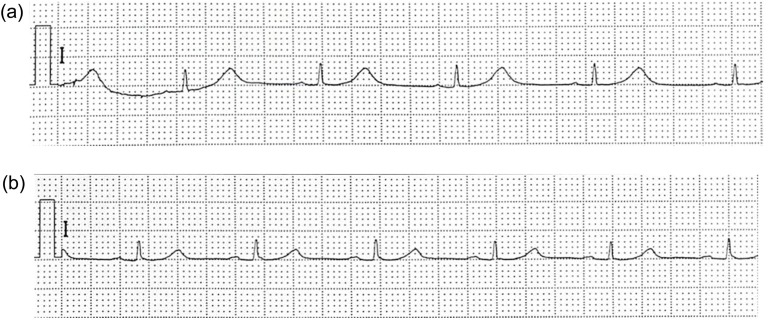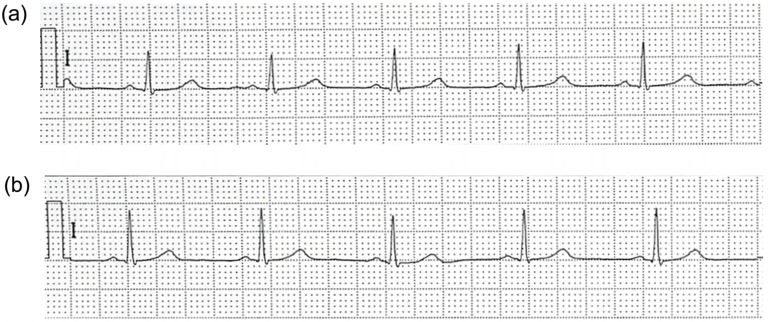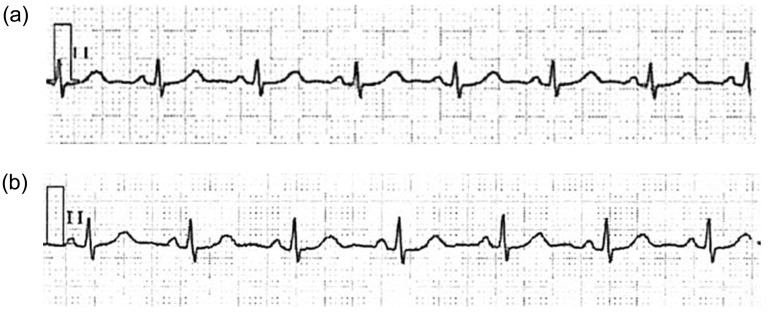J Dent Anesth Pain Med.
2017 Dec;17(4):323-327. 10.17245/jdapm.2017.17.4.323.
QT-interval prolongation due to medication found in the preoperative evaluation
- Affiliations
-
- 1Department of Oral and Maxillofacial Surgery, Faculty of Medicine, Fukuoka University, Fukuoka, Japan. miichan@minf.med.fukuoka-u.ac.jp
- KMID: 2399804
- DOI: http://doi.org/10.17245/jdapm.2017.17.4.323
Abstract
- QT prolongation is an electrocardiographic change that can lead to lethal arrhythmia. Acquired QT prolongation is known to be caused by drugs and electrolyte abnormalities. We report three cases in which the prolonged QT interval was improved at the time of operation by briefly discontinuing the drugs suspected to have caused the QT prolongation observed on preoperative electrocardiography. The QTc of cases 1, 2, and 3 improved from 518 to 429 ms, 463 to 441 ms, and 473 to 443 ms on discontinuing the use of a gastrointestinal prokinetic agent, a proton pump inhibitor, and a molecular targeted drug, respectively. These cases were considered to have drug-induced QT prolongation. We reaffirmed that even drugs administered for conditions unrelated to cardiac diseases can have adverse side effect of QT prolongation. In conclusion, our cases indicate that dental surgeons should be aware of the dangerous and even potentially lethal side effects of QT prolongation. For safe oral and maxillofacial surgery, cooperation with medical departments in various fields is important.
MeSH Terms
Figure
Reference
-
1. Kezerashvili A, Khattak H, Barsky A, Nazari R, Fisher JD. Azithromycin as a cause of QT-interval prolongation and torsade de pointes in the absence of other known precipitating factors. J Interv Card Electrophysiol. 2007; 18:243–246. PMID: 17546486.
Article2. Leitch A, McGinness P, Wallbridge D. Calculate the QT interval in patients taking drugs for dementia. BMJ. 2007; 335:557. PMID: 17855324.
Article3. Tisdale JE. Drug-induced QT interval prolongation and torsades de pointes: role of the pharmacist in risk assessment, prevention and management. Can Pharm J (Ott). 2016; 149:139–152. PMID: 27212965.4. Moss AJ, Schwartz PJ, Crampton RS, Tzivoni D, Locati EH, MacCluer J, et al. The long QT syndrome. Prospective longitudinal study of 328 families. Circulation. 1991; 84:1136–1144. PMID: 1884444.
Article5. Morganroth J, Horowitz LN. Incidence of proarrhythmic effects from quinidine in the outpatient treatment of benign or potentially lethal ventricular arrhythmias. Am J Cardiol. 1985; 56:585–587. PMID: 3901720.
Article6. Soyka LF, Wirtz C, Spangenberg RB. Clinical safety profile of sotalol in patients with arrhythmias. Am J Cardiol. 1990; 65:74A–81A. discussion 82A-83A.
Article7. Litwin JS, Kleiman RB, Gussak I. Acquired (Drug-Induced) Long QT Syndrome. In : Gussak I, Antzelevitch C, Wilde AAM, Friedman PA, Ackerman MJ, Shen WK, editors. Electrical Diseases of the Heart. London: Springer;2008. p. 705–718.9. Pratt CM, Singh SN, Al-Khalidi HR, Brum JM, Holroyde MJ, Marcello SR, et al. The efficacy of azimilide in the treatment of atrial fibrillation in the presence of left ventricular dysfunction: results from the Azimilide Postinfarct Survival Evaluation (ALIVE) trial. J Am Coll Cardiol. 2004; 43:1211–1216. PMID: 15063432.10. ICH Harmonised Tripartite Guideline. The clinical evaluation of QT/QTc interval prolongation and proarrhythmic potential for non-antiarrhythmic drugs. E14. 2005. Available from www.ich.org/fileadmin/Public_Web_Site/ICH_Products/Guidelines/Efficacy/E14/E14_Guideline.pdf.
- Full Text Links
- Actions
-
Cited
- CITED
-
- Close
- Share
- Similar articles
-
- Torsade de pointes in liver transplantation recipient after induction of general anesthesia: a case report
- Ventricular arrhythmia in patients with prolonged QT interval during liver transplantation: two cases report
- Fever-Induced QTc Prolongation and Ventricular Fibrillation in a Healthy Young Man
- Investigation of the Proarrhythmic Effects of Antidepressants according to QT Interval, QT Dispersion and T Wave Peak-to-End Interval in the Clinical Setting
- QTc prolongation in patients with COVID-19: a retrospective chart review




